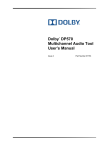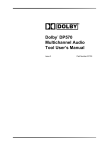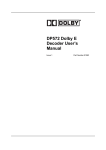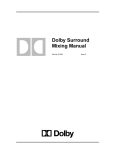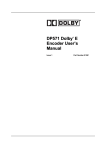Download Dolby Laboratories DP570 User manual
Transcript
Dolby Installation Guidelines Dolby Installation Guidelines S01/13621 i Issue 1 Dolby Installation Guidelines Dolby Laboratories, Inc. Corporate Headquarters Dolby Laboratories, Inc. 100 Potrero Avenue San Francisco, CA 94103-4813 Telephone 415-558-0200 Fax 415-863-1373 www.dolby.com European Headquarters Dolby Laboratories Wootton Bassett Wiltshire SN4 8QJ, England Telephone (44) 1793-842100 Fax (44) 1793-842101 Far East Dolby Laboratories International Services, Inc. Japan Branch Fuji Chuo Building 6F 2-1-7, Shintomi, Chuo-ku Tokyo 104-0041 Japan Telephone (81) 3-5542-6160 Fax (81) 3-5542-6158 Dolby Laboratories Representative Office 7/Fl., Hai Xing Plaza, Unit H 1 Rui Jin Road (S) Shanghai 200023 China Telephone (86) 21-6418-1015 Fax (86) 21-6418-1013 Dolby Laboratories Representative Office Suite 1208, Canway Building No. 66 Nanlishi Road Xichen District Beijing 100045 China Telephone (86) 10-6802-9727 Dolby, Dolby Surround Pro Logic, AC-3, and the double-D symbol are trademarks of Dolby Laboratories. 2001 Dolby Laboratories, Inc.; all rights reserved. S01/13621 Issue 1 ii Dolby Installation Guidelines Table of Contents List of Figures ........................................................................................................................vi List of Tables ........................................................................................................................vii Chapter 1 Overview ........................................................................................................1-1 1.1 DP562 ..................................................................................................1-1 1.2 DP563 ..................................................................................................1-1 1.3 DP569 ..................................................................................................1-1 1.4 DP570 ..................................................................................................1-2 1.5 DP571 ..................................................................................................1-2 1.6 DP572 ..................................................................................................1-2 1.7 DM100 .................................................................................................1-2 Chapter 2 Unit Connections and Dimensions ...............................................................2-1 2.1 DP562 ..................................................................................................2-1 2.2 Audio Connections .............................................................................2-1 2.2.1 Serial I/O .................................................................................2-1 2.2.2 Status Activity and Remote Level Control ...........................2-2 2.3 DP563 ..................................................................................................2-3 2.3.1 Dimensions .............................................................................2-3 2.3.2 Audio Connections ................................................................2-4 2.3.3 Serial I/O (Remote)................................................................2-4 2.3.4 Auxiliary Data .........................................................................2-4 2.4 DP569 ..................................................................................................2-4 2.4.1 Dimensions .............................................................................2-4 2.4.2 Audio Connections ................................................................2-5 2.4.3 Vertical Interval Time Code Input .........................................2-5 2.4.4 Linear Time Code Input.........................................................2-5 2.4.5 TTL Delay Input .....................................................................2-5 2.4.6 Serial I/O (Remote)................................................................2-5 2.4.7 General Purpose I/O .............................................................2-6 2.4.8 Auxiliary Data .........................................................................2-8 2.5 DP570 ..................................................................................................2-8 2.5.1 Dimensions .............................................................................2-8 2.5.2 Audio Connections ................................................................2-8 2.5.3 Video Reference ....................................................................2-9 2.5.4 Serial I/O (Remote)..............................................................2-10 2.5.5 General Purpose I/O ...........................................................2-10 2.5.6 Metadata Inputs ...................................................................2-10 2.5.7 Metadata Output ..................................................................2-10 2.5.8 10BASE-T.............................................................................2-10 iii Dolby Installation Guidelines 2.6 2.7 2.8 DP571 ................................................................................................2-11 2.6.1 Dimensions ...........................................................................2-11 2.6.2 Audio Connections ..............................................................2-11 2.6.3 Video Reference ..................................................................2-11 2.6.4 LTC Input ..............................................................................2-11 2.6.5 Serial I/O (Remote)..............................................................2-12 2.6.6 General Purpose Input/Output (Status Port) .....................2-12 2.6.7 Auxiliary Data .......................................................................2-13 2.6.8 Metadata Input .....................................................................2-13 2.6.9 10BASE-T.............................................................................2-13 DP572 ................................................................................................2-13 2.7.1 Dimensions ...........................................................................2-13 2.7.2 Audio Connections ..............................................................2-13 2.7.3 Video Reference ..................................................................2-14 2.7.4 LTC Output ...........................................................................2-14 2.7.5 Serial I/O (Remote)..............................................................2-14 2.7.6 General Purpose Input/Output (Status Port) .....................2-14 2.7.7 Auxiliary Data .......................................................................2-16 2.7.8 Metadata Output ..................................................................2-16 2.7.9 10BASE-T.............................................................................2-16 DM100 ...............................................................................................2-17 2.8.1 Dimensions ...........................................................................2-17 2.8.2 Audio Connections ..............................................................2-17 2.8.3 Video Reference ..................................................................2-17 Chapter 3 Installation Issues ............................................................................................3-1 3.1 Venting.................................................................................................3-1 3.2 Timing and Delays ..............................................................................3-1 3.2.1 Dolby Surround ......................................................................3-1 3.2.2 Dolby Digital ...........................................................................3-2 3.2.3 Dolby E ...................................................................................3-2 3.3 Setup and Calibration .........................................................................3-2 Chapter 4 Hot Standby and Alarms .................................................................................4-1 4.1 DP562 ..................................................................................................4-1 4.2 DP563 ..................................................................................................4-1 4.3 DP569 ..................................................................................................4-1 4.4 DP570 ..................................................................................................4-2 4.5 DP571 ..................................................................................................4-2 4.6 DP572 ..................................................................................................4-2 iv Dolby Installation Guidelines Chapter 5 Common Applications .....................................................................................5-1 5.1 DVD Authoring ....................................................................................5-1 5.2 Monitoring Dolby E/Dolby Digital and Dolby Surround Production 5-1 5.2.1 Using a DP570 .......................................................................5-2 5.2.2 Monitoring with a DP569 and DP562...................................5-3 Chapter 6 Serial Communications ..................................................................................6-1 6.1 RS-232 Ports.......................................................................................6-1 6.2 RS-485.................................................................................................6-2 6.3 Metadata Connections .......................................................................6-3 6.4 Serial Control ......................................................................................6-4 v Dolby Installation Guidelines List of Figures 2-1 2-2 2-3 2-4 2-5 4-1 5-1 5-2 5-3 5-4 6-1 Front and Back Panels of the DP562 .........................................................................................2-1 Test Box Schematic....................................................................................................................2-3 Front and Back Panels of the DP563 .........................................................................................2-3 Front and Back Panels of DP569 ...............................................................................................2-4 Diagram of Voiceover and Switched Output Operation............................................................2-16 Hot Standby Operation of the DP569 .........................................................................................4-2 Typical DVD Encoding System...................................................................................................5-1 Example Equipment Setup for Postproduction Studio or OB Truck...........................................5-2 Example Equipment Setup for use with Consoles with Full Monitoring Functions.....................5-3 Dolby Digital/Surround Monitoring..............................................................................................5-4 Metadata Multidrop .....................................................................................................................6-4 vi Dolby Installation Guidelines List of Tables 2-1 2-2 2-3 2-4 2-5 2-6 2-7 2-8 2-9 2-10 2-11 3-1 6-1 6-2 6-3 6-4 6-5 Pin Connections for Status/Remote Port....................................................................................2-2 Pin Connections of GPI/O In Port...............................................................................................2-6 Pin Connections of GPI/O Out Port ............................................................................................2-7 Pin Connections for the Cat. No. 548 Analog Option Card Multichannel Output .......................2-9 Pin Connections for the Cat. No. 548 Analog Option Card Stereo/Mono Output.......................2-9 Pin Connections for the Cat. No. 548 Analog Option Card Stereo/Mono Output.....................2-10 Pin Connections of GPI/O Port .................................................................................................2-12 Status Port Preset Selection.....................................................................................................2-12 Preset Mode Tally Indication on Status Port ............................................................................2-13 Pin Connections for the Status Port .........................................................................................2-15 Status port Output Routing Mode Selection .............................................................................2-15 Dolby Digital Coding and Decoding Delays................................................................................3-2 Pin Connections for 9-Pin RS-232 Ports (DP562 and DP572)...................................................6-1 Pin Connections for 9-Pin RS-232 Ports (DP571)......................................................................6-2 Pin Connections for 8-Pin RS-232 Ports ....................................................................................6-2 Pin Connections for RS-485 Ports (Excluding Metadata Outputs).............................................6-3 Pin Connections for Metadata Output Ports ...............................................................................6-3 vii Dolby DMU AD/DA Converter 3-1 Dolby Installation Guidelines Chapter 1 Overview This document will help users correctly install Dolby pro audio products into broadcast, postproduction, and other environments. (Operation of each unit is not covered in this document; for this information, refer to the dedicated user manual supplied with each unit. Additional copies of user manuals can be also obtained from Dolby Laboratories.) Upon purchasing a new Dolby product, please register it on www.dolby.com. Doing so will enable us to notify you of product upgrades and send other information of interest. The units detailed in this document are the DP562, DP563, DP569, DP570, DP571, DP572, and DM100. 1.1 DP562 The DP562 is a multichannel reference decoder incorporating both Dolby Digital and Dolby Surround Pro Logic decoding. When producing material in Dolby Surround, the unit allows the effects of the encode/decode process to be monitored. When used for monitoring Dolby Digital encoding, it allows the effects of metadata to be auditioned, and the various downmixes to be heard. 1.2 DP563 The DP563 is a fully digital implementation of the Dolby Surround matrix encoder used in the analog SEU4 Dolby Surround Encoder. It has six digital inputs so that 5.1 material can be automatically downmixed to four channels before it is encoded. This unit is usually used in conjunction with a DP562 or DP570. 1.3 DP569 The DP569 Dolby Digital Encoder takes up to six input channels (for 5.1-channel operation) and outputs an encoded Dolby Digital bitstream. The DP569 can use metadata generated by another unit and can be controlled by a Windows PC using the supplied DolbyRemote software. A DP562 is used to monitor the encoded Dolby Digital bitstream. 1-1 Dolby Installation Guidelines 1.4 Overview DP570 The DP570 Multichannel Audio Tool allows users to generate metadata for input into either a Dolby E or Dolby Digital encoder, and to monitor the effects of metadata on an audio source in real time. It also includes features such as multiple speaker selection, audio channel routing (which eliminates the need for an external router), and separate inputs for Dolby Surround Pro Logic decoding and 5.1-channel monitor configuration. 1.5 DP571 The DP571 Dolby E Encoder encodes up to eight PCM audio channels plus Dolby Digital metadata into a single AES3 channel pair. Its one-frame PCM audio delay keeps linear PCM audio in sync with Dolby E encoded audio. 1.6 DP572 The DP572 Dolby E Decoder decodes up to eight channels of high-quality PCM audio plus Dolby Digital metadata from a single Dolby E-encoded AES3 pair, or from two audio tracks on a digital videotape, digital audio tape, or video server. 1.7 DM100 The DM100 Bitstream Analyzer is a very useful tool for installation engineers. It is a handheld, portable diagnostic tool that can monitor Dolby Digital, Dolby E, and PCM bitstreams. It can also generate test streams in any of the above formats. Structure of this Document Chapter 2 of this document details the connectivity of each unit, including input and output formats, and signal levels of the status ports. Physical dimensions for each unit are also detailed in this section. Chapter 3 covers typical installation issues, such as setup and calibration procedures for some of the units. Chapter 4 discusses redundant operation between Dolby products, useful in broadcast and other applications. Chapter 5 provides descriptions of common applications for Dolby pro audio products. This chapter also includes wiring details for these applications. Chapter 6 discusses units that can be controlled remotely via serial port connection. It also covers details of the auxiliary data ports and metadata connections that can be required between the units. 1-2 Dolby Installation Guidelines Chapter 2 Unit Connections and Dimensions 2.1 DP562 Figure 2-1 Front and Back Panels of the DP562 Dimensions The DP562 occupies one rack unit and measures 45 × 483 × 305 mm (1.75 × 19 × 12 inches). Its net weight is 4.5 kg (9.9 lb). 2.2 Audio Connections The digital audio input is a 3-pin female XLR connector. The input will accept either PCM in AES/EBU format or Dolby Digital (AC-3) in IEC 1937 format (formerly IEC 958 Annex B) as specified in ATSC A/52 Annex B. The digital audio outputs are 3-pin male XLR connectors. The outputs are PCM in AES/EBU format (5 Vp-p, 110Ω). The analog audio outputs are balanced and use 3-pin male XLR connectors (0 dBFS = +24 dBu). The output impedance is 25Ω. The headphone output is a ¼-inch standard audio headphone jack with +11.5 dBu maximum output into 600Ω nominal. 2.2.1 Serial I/O The DP562 has a rear-panel RS-232 port. This port is used for software upgrades and can also be used to control most of the functions of the DP562. The unit must be in Remote Control mode before it will accept commands through the Serial I/O port. Remote Control mode is enabled in the User Menu, which is entered by holding down 2-1 Dolby Installation Guidelines Unit Connections and Dimensions the User button for three seconds. The LED on the User button will illuminate when the user option is selected. This option is only available in version 2.5 or later of the unit software. See Section 6.4 for further information. The DP562 communicates at 9.6 kbps and has a fixed unit address of 8282. 2.2.2 Status Activity and Remote Level Control The Status/Remote connector on the rear panel allows remote monitoring of the status output activity and remote control of the analog output level. When the remote level control is enabled, the internal master level control is disabled. Table 2-1 Pin Connections for Status/Remote Port Pin Connection Comments 1 Fault Processor/memory fault 2 AC-3/PCM 1 = AC-3 bitstream; 0 = Non AC-3 3 AC-3 CRC Error 4 AC-3 CRC Error (+5 V) AC-3 CRC error encountered during decode Pin 3 and pin 4 is closed for 100 ms when a CRC error is detected 5 Ground (and pot “low”) 6 Pot wiper 7 Pot “hi” 8 Remote LED 1 = Remote Fader selected 9 Remote Switch Select Remote Fader Controls remote level The table above contains details of the pin connections for the Status/Remote port. The test box shown in the figure below can be used as an example for monitoring Status/Remote port activity and controlling the analog output level remotely. A 10kΩ potentiometer is often used for the remote level control. 2-2 Dolby Installation Guidelines Unit Connections and Dimensions Figure 2-2 Test Box Schematic 2.3 DP563 Figure 2-3 Front and Back Panels of the DP563 2.3.1 Dimensions The DP563 occupies one rack unit and measures 44 × 483 × 324 mm (1.75 × 19 × 12.75 inches). Its net weight is 4.6 kg (10.1 lb). 2-3 Dolby Installation Guidelines 2.3.2 Unit Connections and Dimensions Audio Connections The digital audio inputs and reference input are provided on female BNC connectors. Input signals should be compliant with AES3-id-1995 (unbalanced, 75Ω, 1V peak-topeak standard output). AES3-id signals are very similar to analog composite video, although dedicated AES3 distribution equipment should be used. If the loop-through BNC connectors are not being used to feed additional equipment, terminate them with a standard 75Ω video terminator. The digital audio output is provided on a female BNC connector. The output is 75Ω, unbalanced, with signal levels compliant with AES3-id-1995. 2.3.3 Serial I/O (Remote) The DP563 allows remote control via the front-panel (RS-232) or rear-panel (RS485) ports. It is able to communicate at rates of 9.6 kbps, 19.2 kbps, or 38.4 kbps. The unit address can be any discrete tributary address as specified in SMPTE RP 1131996. See Section 6.4 for further information. The default address is 8280, and the serial I/O connections can also be used for software upgrades. 2.3.4 Auxiliary Data The Aux Data port is an RS-485 port that may be used for future enhancements. See Section 5.2 for pin assignments. 2.4 DP569 Figure 2-4 Front and Back Panels of DP569 2.4.1 Dimensions The DP569 occupies one rack unit and measures 44 × 483 × 324 mm (1.75 × 19 × 12.75 inches). Its net weight is 4.7 kg (10.3 lb). 2-4 Dolby Installation Guidelines 2.4.2 Unit Connections and Dimensions Audio Connections The digital audio inputs and reference input are provided on female BNC connectors. Input signals should be compliant with AES3-id-1995 (unbalanced, 75Ω, 1V peak-topeak standard output). AES3-id signals are very similar to analog composite video, although dedicated AES3 distribution equipment should be used. If the loop-through BNC connectors are not being used to feed additional equipment, terminate them with a standard 75Ω video terminator. The main digital output is a female BNC connector. The encoded data is formatted in accordance with the ATSC A/52 Annex B specification, and signal levels are in conformance with AES3-id-1995. The nominal output impedance is 75Ω. The bypass input is routed to the switched output when the unit is in bypass mode. The unit enters bypass mode when an internal fault occurs or power to the unit is lost. The operator can also select this mode. The key use for this feature is for “hot standby” operation. See Section 4.3 for further details. 2.4.3 Vertical Interval Time Code Input If using SMPTE vertical interval time code (VITC), connect the composite video signal to the VITC In BNC connector using a 75Ω shielded cable. There is a loop-through connection that will require a 75Ω termination if this facility is not being used. 2.4.4 Linear Time Code Input If using SMPTE linear time code (LTC), connect the LTC signal to the LTC input using a male XLR connector. 2.4.5 TTL Delay Input The TTL delay input can be used to control the encoding delay of the DP569 remotely. This port accepts a TTL level signal with an active high-pulse width that corresponds to the desired delay. It may be driven by a video frame sync or related equipment to automatically match the DP569 encoding delay with an associated video delay. 2.4.6 Serial I/O (Remote) The DP569 allows remote control of the unit via the front-panel (RS-232) or rearpanel (RS-485) ports. To place the unit into remote mode, press the Shift button, followed by the left arrow button. Dolby has developed DolbyRemote, a user interface for the Windows operating system. This is supplied with each DP569, and provides a user-friendly control system for most of the unit’s functions. The serial I/O connections can also used for software upgrades. 2-5 Dolby Installation Guidelines Unit Connections and Dimensions The DP569 can communicate at rates of 9.6, 19.2, or 38.4 kbps. The unit address can be any discrete tributary address as specified in SMPTE RP 113-1996. See Section 6.4 for further information. 2.4.7 General Purpose I/O The GP I/O ports on the DP569 have female 9-pin D-connectors, and operate at 5 V CMOS output levels. General Purpose Status Input Port (GP I/O In) Table 2-2 Pin Connections of GPI/O In Port Pin Connection Comments 1 Bypass Select Bypass Input as source for Switched Output 2 Autodetect Autodetect and pass-through valid AC-3 signals 3 Pre-encoded Force Pass-Through mode (no AC-3 encoding) 4 PCM Force AC-3 encoding (no Pass-through mode) 5 User Preset 1 Select User Preset 1 6 User Preset 2 Select User Preset 2 7 User Preset 3 Select User Preset 3 8 User Preset 4 Select User Preset 4 9 Ground Pin 1 Connecting pin 1 to ground (pin 9) will place the unit into Bypass mode. This will occur regardless of the setting of the Bypass mode parameter in the I/O control menu. However, enabling bypass in the menu will also place the unit into bypass, regardless of the presence of this connection. Pins 2–4 In order to select one of these modes, a high-to-low transition should be placed on a pin. The input format corresponding to the pin will be selected, as long as the selection does not conflict with another setting (such as clock source). As only one of these settings can be selected, the input formats will be active in the order that they are selected. A low-tohigh transition on these pins will not have any effect. Pins 5–8 These operate in the same way as pins 2–4. The relevant preset will be recalled immediately if a high-to-low transition occurs. If pin 1 is grounded, then bypass operation will be active irrespective of the setting of Bypass mode within the preset. 2-6 Dolby Installation Guidelines Unit Connections and Dimensions General Purpose Status Output Port (GPI/O Out) Table 2-3 Pin Connections of GPI/O Out Port Pin 1 2 3 4 5 6 7 8 9 Connection Fault Lock Pass-through Encoding User Preset 1 User Preset 2 User Preset 3 User Preset 4 Ground Comments Power supply or processor/memory fault Valid input and clock sources present and stable Valid AC-3 input signal being passed through AC-3 encoding of input signal active User Preset 1 selected User Preset 2 selected User Preset 3 selected User Preset 4 selected Pin 1 This output corresponds to the front-panel Fault LED. When a power supply or internal hardware fault is detected, the Fault LED illuminates and the corresponding output signal goes low. When no fault is detected, the LED does not illuminate and the output signal remains high. Pin 2 This output reports the status of both the selected input source and clock source. A high level on this signal indicates that both sources are “valid” (i.e., locked and stable). A high level does not guarantee a valid output, only that the input state is valid. A low level will imply that a valid output is not being produced. Pin 3 This output reflects the status of Pass-Through mode. A high level indicates that pass-through is not active. A low level indicates that passthrough is active (i.e., that a valid encoded bitstream is being passed through). Pin 4 This output reflects the state of the Dolby Digital (AC-3) encoding process. A high-level output indicates that the Dolby Digital encoding process is not active. A low-level output indicates that the Dolby Digital encoding process is active. (This includes test tone modes.) Note: The combination of the pass-through and encoding outputs indicates the DP569 output status. A low level on either output means that the DP569 is producing a valid encoded output signal. Pins 5-8 These outputs are directly tied to the respective front-panel preset LEDs. An active preset state causes the corresponding preset LED to illuminate, and the corresponding output signal to be low. When the corresponding preset state is not active, the output will be high. 2-7 Dolby Installation Guidelines 2.4.8 Unit Connections and Dimensions Auxiliary Data The Aux Data port is an RS-485 port. See Section 5.2 for pin assignments. In later versions of the unit software (v. 1.17 or later), this port can be used as an input for external metadata. This could be from the metadata output on a DP572 or from another metadata source. 2.5 DP570 Figure 2–5 Front and Back Panels of the DP570 2.5.1 Dimensions The DP570 occupies 2U of rack space and measures 88 × 483 × 330 mm (3.5 × 19 × 13 inches). Its net weight is 3.6 kg (7.9 lb). 2.5.2 Audio Connections The digital audio inputs and Lt/Rt input are provided on female BNC connectors. The Lt/Rt input has a loop-through connection that requires 75Ω termination if this facility is not being used. The inputs should be compliant with AES3-id-1995. There are two sets of digital audio outputs. One of the sets is from the output of the input router, the other set is from the emulator. The digital audio outputs are provided on a female BNC connector. The output is 75Ω, unbalanced, with signal levels compliant with AES3-id-1995. There are two sets of digital outputs: channel emulator and router outputs. If the Cat. No. 548 Analog Option Card is fitted, then independent 5.1, two-channel and mono analog outputs are available. These are provided on two 25-pin D-connectors. 2-8 Dolby Installation Guidelines Unit Connections and Dimensions Table 2-4 Pin Connections for the Cat. No. 548 Analog Option Card Multichannel Output Pin 1 2 3 4 5 6 7 8 9 10 11 12 13 Connection Bsr + Out Bsr Ground Bsl – Out Rs + Out Rs Ground Ls – Out Subwoofer + Out SW Ground Center – Out Right + Out R Ground Left – Out — Pin 14 15 16 17 18 19 20 21 22 23 24 25 Connection Bsr - Out Bsl + Out Bsl Ground Rs - Out Ls + Out Ls Ground Subwoofer - Out Center + Out C Ground Right - Out Left + Out L Ground Table 2-5 Pin Connections for the Cat. No. 548 Analog Option Card Stereo/Mono Output Pin 1 2 3 4 5 6 7 8 9 10 11 12 13 2.5.3 Connection Digital Ground — — — — Solo In R Solo In L + SL Ground Mono – Out Right Stereo + Out R Ground Left Stereo - Out — Pin 14 15 16 17 18 19 20 21 22 23 24 25 Connection — — — — Solo In R + SR Ground Solo In L Mono + Out M Ground Right Stereo – Out Left Stereo + Out L Ground Video Reference A composite video signal should be connected to the video ref. BNC connector using a 75Ω shielded cable. There is a loop-through connection that will require a 75Ω termination if this facility is not being used. 2-9 Dolby Installation Guidelines 2.5.4 Unit Connections and Dimensions Serial I/O (Remote) The DP570 will allow remote control via the front-panel (RS-232) or rear-panel (RS485) ports. See Section 6.4 for further information. The serial I/O connections can also used for software upgrades. 2.5.5 General Purpose I/O The DP570 has a 37-pin female D-connector for the GPI/O connections. Most of these connections are user definable, but there are a few standard connections. Table 2-6 Pin Connections for the Cat. No. 548 Analog Option Card Stereo/Mono Output Pin 1 2 3 4 5 6 2.5.6 Function +5 V (150 mA) Fault Output Error Output User Defined Output Solo Tally Output Solo Control Input Pin 7-19 20 21 22 23-36 37 Function User Defined Outputs Encoder A Input Encoder B Input Encoder Present Input User Defined Inputs Digital ground Metadata Inputs The metadata input ports are RS-485 ports. These can be used for the input of metadata from a DP572 or other metadata source. See Section 5.2 for pin assignments. 2.5.7 Metadata Output The metadata output port is an RS-485 port. This can be used for the output of metadata to a DP569, DP571, or other unit with metadata input. See Section 5.2 for pin assignments. 2.5.8 10BASE-T This port will be implemented in future versions. 2-10 Dolby Installation Guidelines 2.6 Unit Connections and Dimensions DP571 Figure 2-6 Front and Back Panels of the DP571 2.6.1 Dimensions The DP571 occupies one rack unit and measures 44 × 483 × 324 mm (1.75 × 19 × 12.75 inches). Its net weight is approximately 2.7 kg (6 lb). 2.6.2 Audio Connections The digital audio inputs are provided on female BNC connectors. Input signals should be compliant with AES3-id-1995 (unbalanced, 75Ω, 1V peak-to-peak standard output). AES3-id signals are very similar to analog composite video, although dedicated AES3 distribution equipment should be used. If the loop-through BNC connectors are not being used to feed additional equipment, terminate them with a standard 75Ω video terminator. The PCM delay input is of the same specification, except that no termination is required as the PCM output is electrically isolated. The main outputs and the PCM delay output are on female BNC connectors. The output is formatted in accordance with AES3-id-1995. The nominal output impedance for these connectors is 75Ω. The main outputs are electrically isolated and therefore no termination is required. 2.6.3 Video Reference A composite video signal should be connected to the video ref. BNC connector using a 75Ω shielded cable. There is a loop-through connection that will require a 75Ω termination if this facility is not being used. 2.6.4 LTC Input The DP571 accepts a SMPTE LTC signal. After decoding in the LTC receiver, the resulting time code information is passed to the DSP subsystem. 2-11 Dolby Installation Guidelines 2.6.5 Unit Connections and Dimensions Serial I/O (Remote) Future versions of the DP571 will allow remote control via the front-panel (RS-232) or rear-panel (RS-485) ports. See Section 6.4 for further information. The serial I/O connections can also used for software upgrades. 2.6.6 General Purpose Input/Output (Status Port) The input and output signals are 0–5 V TTL. Table 2-7 Pin Connections of GPI/O Port Pin 1 2 3 4 5 6 7 8 9 Connection Preset Tally A Reference Video Valid Dolby E Encoding Valid System Operational Fault Preset Tally B Preset Ctrl A Preset Ctrl B Ground Comments Preset tally output 1: Valid; 0: Ref video error 1: Valid; 0: Encoding error 1: Functional 0: Failed 1: Functional 0: Hardware Fault Preset tally output Preset control input Preset control input — Pins 1 and 6 Presets 1–3 generate corresponding outputs on the status port that can be used to indicate selection of a preset via the status port, serial remote port (in future versions), or the front panel. Table 2-8 Status Port Preset Selection Preset Tally A (Pin 1) Preset Tally B (Pin 6) Preset Low High 1 High Low 2 Low Low 3 High High Other or no preset Pins 2-5 These indicate the current condition of the unit. A “1” corresponds to a high level on the corresponding pin. Pins 7-8 The two inputs on pins 7 and 8 select among the first three (of eight) presets stored in the DP571. The inputs are normally high (internal pullup) and trigger a preset recall by sensing a momentary high-to-low transition. 2-12 Dolby Installation Guidelines Unit Connections and Dimensions Table 2-9 Preset Mode Tally Indication on Status Port Pin 7 Transition High-to-Low None or Low-to-High High-to-Low 2.6.7 Pin 8 Transition None or Low-to-High High-to-Low High-to-Low Preset 1 2 3 Auxiliary Data The Auxiliary Data port is a 9-pin female RS-232 port that may be used for future enhancements. See Section 5.2 for pin assignments. 2.6.8 Metadata Input The metadata input port is an RS-485 port. This can be used for the input of metadata from a DP572 or other metadata source. See Section 5.2 for pin assignments. 2.6.9 10BASE-T This port will be implemented in future versions. 2.7 DP572 Figure 2-7 Front and Back Panels of the DP572 2.7.1 Dimensions The DP572 occupies one rack unit and measures 44 × 483 × 324 mm (1.75 × 19 × 12.75 inches). Its net weight is approximately 2.7 kg (6.0 lb). 2.7.2 Audio Connections The main input is provided on a female BNC connector. The inputs should be compliant with AES3-id-1995 (unbalanced, 75Ω, 1V peak-to-peak standard output). 2-13 Dolby Installation Guidelines Unit Connections and Dimensions AES3-id signals are very similar to analog composite video, although dedicated AES3 distribution equipment should be used. If the loop-through BNC connectors are not being used to feed additional equipment, terminate them with a standard 75Ω video terminator. The PCM delay input is of the same specification as the main input, except that no termination is required as the PCM output is electrically isolated. The digital outputs and the PCM delay output are on female BNC connectors. The outputs are formatted in accordance with AES3-id-1995. The nominal output impedance for these connectors is 75Ω. The secondary digital outputs are electrically isolated and therefore no termination is required. The headphone output is a ¼-inch standard audio headphone jack with +11.5 dBu maximum output into 600Ω nominal. 2.7.3 Video Reference A composite video signal should be connected to the video ref. BNC connector using a 75Ω shielded cable. There is a loop-through connection that will require a 75Ω termination if this facility is not being used. 2.7.4 LTC Output After de-multiplexing time-code information from the Dolby E stream, the DP572 provides a standard SMPTE LTC output. 2.7.5 Serial I/O (Remote) Future versions of the DP572 will allow remote control via the front-panel (RS-232) or rear-panel (RS-485) ports. See Section 6.4 for further information. The serial I/O connections can also used for software upgrades. 2.7.6 General Purpose Input/Output (Status Port) The input and output signals are 0–5 V TTL. 2-14 Dolby Installation Guidelines Unit Connections and Dimensions Table 2-10 Pin Connections for the Status Port Pin 1 2 3 4 5 6 7 8 9 Direction Output Output Output Output Output Output Input Input N/A Connection Dolby E Detect Reference Video Valid Dolby E Decoding Valid System Operational Fault Reserved PCM channel routing PCM channel routing Ground Comments 1: Dolby E 0: PCM or none 1: Valid; 0: Ref video error 1: Valid; 0: Decoding error 1: Functional 0: Failed 1: Functional 0: Hardware Fault — Voiceover and Switched mode Voiceover and Switched mode — Pins 1–5 These indicate details regarding the current condition of the unit. A “1” corresponds to a “high” level on the corresponding pin. Pins 7–8 These can be used to select Voiceover and Switched Out modes. The state of the pins is normally high (internal pull up), and they detect a high-tolow transition. A held contact closure between pins 7 and 9 (ground) or pins 8 and 9 is required to activate a function. A low-to-high transition (i.e., a switch release) restores the delay out setting. The table below shows the function of the two GPI pins on the DP572. Table 2-11 Status port Output Routing Mode Selection Ctrl in Pin 8 Ctrl in Pin 7 High High Low Low High Low High Low PCM Chan Config Output Routing Mode Delay Out Voiceover Switched Out Reserved Figure 2-5 details the channel routing of these modes for a 5.1 input. 2-15 Dolby Installation Guidelines Unit Connections and Dimensions Figure 2-5 Diagram of Voiceover and Switched Output Operation Use the Voiceover and Switched Output functions when only basic control and editing functions are required. One example may be a local transmission center where the switched output could be used to insert a local commercial delivered as stereo PCM audio. The DP572 can also be used to insert voice-overs. This is advantageous, because recording the voice-over might otherwise require 5.1-channel editing facilities. 2.7.7 Auxiliary Data The Auxiliary Data port is a 9-pin male RS-232 port that may be used for future enhancements. See Section 5.2 for pin assignments. 2.7.8 Metadata Output The metadata output port is an RS-485 port. This can be used for the output of metadata to a DP569, DP571, or other unit with metadata input. See Section 5.2 for pin assignments. 2.7.9 10BASE-T This port will be implemented in future versions. 2-16 Dolby Installation Guidelines 2.8 DM100 2.8.1 Dimensions Unit Connections and Dimensions The DM100 is a handheld device that measures 100 × 200 × 41 mm (4 × 7.9 × 41 inches). Its net weight is 0.68 kg (1.5 lb). 2.8.2 Audio Connections Audio I/O is available on XLR, BNC, or Toslink connectors. The female XLR connection has an internal 110Ω termination, and the female BNC input has an internal 75Ω termination. The male XLR output has 110Ω impedance, and the female BNC output has 75Ω impedance. 2.8.3 Video Reference A composite video signal can be connected to the video reference input. This connection is a female phono connector. There is an internal 75Ω termination. A phono-to-BNC adapter is supplied with the DM100. 2-17 Dolby DMU AD/DA Converter 3-1 Dolby Installation Guidelines Chapter 3 Installation Issues 3.1 Venting The Dolby professional audio products are designed to operate within a temperature range of 5° to 45° C. They use natural convection cooling and therefore should not be mounted directly above any heat-generating equipment. DP-series products, with the exception of the DP570, have vent holes in the top and bottom panels, along the left or right edge, depending on the unit (left side for the DP562, DP571, and DP572; right for the DP563 and DP569). The vent holes should not be covered, although units can vent through one another if necessary. In this event, be sure that the venting panels are on the same side on each unit. The number of units that can be vented in this way will depend on the conditions of the room in which they will be installed. The DP570 features vent holes in the front and back of the unit, and can be placed directly above or below other rack-mount gear. 3.2 Timing and Delays Encoding and decoding adds delay to the audio data. In audio-only situations this may be of little consequence, but where the audio has associated video material, care should be taken to ensure that these delays are accounted for. This can be done by adding the equivalent delay to the video stream, by compensating for the delay at the video encoding stage, or by adding an offset between the time code of the source tapes. The amount of the delay varies depending on the technology being used. 3.2.1 Dolby Surround The delay associated with the Dolby Surround encode/decode process is effectively zero. The DP563 does allow for the encoding delay to be varied between minimum (<1 ms) and 100 ms. The DP562 has little latency (approx 3msec@48kHz) when in Disabled or Reference bitstream detect modes, although this increases if bass redirection is used. When in Silent Switch mode, the decoding latency will be the same as for Dolby Digital. Silent Switch mode includes a crossfade when the input switches between different formats. 3-1 Dolby Installation Guidelines 3.2.2 Installation Issues Dolby Digital The amount of delay added by the Dolby Digital encode/decode process varies depending upon the sample rate being used. The table below shows the minimum delay values for encoding. The DP569 allows for the encoding delay to be increased to any value between the minimum value and 450 ms. The decode latency values are fixed, dependent on the bitstream detect mode of the DP562. The encoding delays are correct for v1.22 of the DP569 software. These are likely to change in later versions. Table 3-1 Dolby Digital Coding and Decoding Delays Sample Rate 48 kHz 44.1 kHz 32 kHz 3.2.3 DP569 Minimum Coding Delay 179 ms 195 ms 268 ms DP562 Latency in Disabled/Reference Detect 32 ms 35.7 ms 48.4 ms DP562 Latency in Silent Switch Mode 36.6 ms 42.8 ms 58.3 ms Dolby E The Dolby E encoding and decoding processes each add one frame of delay to the audio. The frame length is that of the incoming video reference signal. If the DP572 is in Program Play mode, then the decoding delay will vary depending on the rate of the incoming Dolby E bitstream. The Dolby E units also have a PCM delay output. This can be used to route the PCM input to the PCM output adding the same delay as is being added by the Dolby E encode process. This can be used to keep a pair of un-encoded audio channels, such as channels three and four from a VTR, in sync with the encoded audio. 3.3 Setup and Calibration To allow correct monitoring of the encoded audio, the DP562 includes adjustments for settings such as analog output level trims and surround delays. For details of how these should be set, refer to the user manual. The DP563 requires calibration with the studio’s operating level. For details of how to perform this calibration, refer to the user manual. The DP570 has different setup options depending on whether the Cat. No. 548 Analog Option Card is fitted. With the analog board fitted the setup options are similar to the DP562. However the DP570 allows for multiple sets of speakers for which level trims can be assigned separately. The DP570 also includes EX decoding and can therefore support up to 7.1 speaker setups. For full details of setting up these speakers please refer to the user manual. 3-2 Dolby Installation Guidelines Chapter 4 Hot Standby and Alarms Many Dolby products allow simple implementation for hot standby applications. Hot standby units and redundancy should be considered at a system level. Systems that utilize hot standby features allow automatic routing of the required signals from a unit that develops a fault, to a spare unit in the system. The Dolby products can easily be integrated into other redundant systems, such as the “n+1” design that is often used for transmission encoding. In such a system, the only signal that would require routing for the audio is a single Dolby E stream. Operating status of the units can be assessed by the control using the GPI/Os. 4.1 DP562 The DP562 features general system alarm and AC-3 decoding status signals as outputs on the status/remote port. For further details of the connections of this port, see Section 2.2.2. 4.2 DP563 There are no GPI/O ports on this unit. However, the DP563 will only stop encoding if there is no valid audio input on channels 1/2 or if there is a hardware fault. 4.3 DP569 The DP569 has a bypass input that can be used to make hot standby operation simple. In order to connect a pair of DP569s for hot standby connection, the following connections should be made. The unit automatically enters Bypass mode when an internal fault occurs or when power is lost. Bypass mode can also be selected from the I/O Control menu or via the GPI/O input port. 4-1 Dolby Installation Guidelines Hot Standby and Alarms Figure 4-1 Hot Standby Operation of the DP569 For further security, pins 1 and 9 (ground) of the GPI/O ports can be used to control a unit fault alert. If pin 1 goes “low,” then a power supply or hardware fault has occurred. These can be used on both the encoders so that a faulty standby encoder can be identified before it is required. Pins 3, 4, and 9 can also be used to ascertain whether the unit is producing an encoded output, and trigger a warning on the console or monitor system. 4.4 DP570 The DP570 has fixed connections on the GP output for fault and error conditions (pins 2 and 3, respectively). For critical live applications, the system design should be such that the DP570 is only part of the monitor path or that these pins can be used to trigger routing to bypass the main audio around the DP570. 4.5 DP571 The status port can be used to control a router, console, or other switching device in the event of a unit failure. Pins 4, 5, and 9 (ground) can be used to check whether a unit is operational. If pin 4 or 5 goes “low,” then either the system is not operational, a hardware fault has occurred, or power has been lost to the unit. By monitoring these pins on both the units, an operator can be alerted to problems with either unit. 4.6 DP572 The DP572 can be used in the same way as the DP571. 4-2 Dolby Installation Guidelines Chapter 5 Common Applications 5.1 DVD Authoring Dolby products are often used in the process of authoring DVD discs. The process requires a DP569 and DP562. A DP572 is also required if the audio is supplied in Dolby E. Using the DolbyRemote software and Dolby Digital recorder package increases ease of use. The Dolby Digital Recorder software utility runs on a Windows 95/98/NT computer with a digital I/O soundcard. It is used to produce .ac3 format files. Figure 5-1 shows the audio equipment in a typical DVD encoding system. Figure 5-1 Typical DVD Encoding System Dolby Laboratories can also supply an interface kit to aid the installation of this system into studios that use either all balanced or unbalanced digital audio connections. This kit is called the DVD-Audio cable kit (Cat. No. 541) and contains four BNC cables along with four impedance transformers. Three of the transformers are female XLR-toBNC connections, and the other has male XLR-to-BNC connections. 5.2 Monitoring Dolby E/Dolby Digital and Dolby Surround Production When a 5.1 mix is being created, and a Dolby Surround encoded mix will also be created, the effects of both processes should be monitored. 5-1 Dolby Installation Guidelines 5.2.1 Common Applications Using a DP570 A few examples are included in this manual for monitoring 5.1 and Dolby Surround production. There are many variations to these setups that will be used, so these are included as a couple of typical designs. Figure 5-2 Example Equipment Setup for Postproduction Studio or OB Truck. Figure 5-2 shows an example where the program audio is fed to the DP570. The channel order of the audio can be modified using the DP570’s router before being fed to the DP563 and DP571. With the analog option fitted, the DP570 can be used to perform many of the monitoring functions. 5-2 Dolby Installation Guidelines Common Applications Figure 5-3 Example Equipment Setup for use with Consoles with Full Monitoring Functions Figure 5-3 shows a setup that uses separate program audio and monitor feeds. In this setup, the console being used should feature the required monitoring functions. 5.2.2 Monitoring with a DP569 and DP562 If a DP570 is not available, it is possible to use a DP562 along with a DP569 and DP563 to perform similar monitoring functions. The setup shown in Figure 5-4 shows how this can be done. No external switching equipment is required, as either a serial remote connection, a GPI/O connection, or the front panel can be used to control the switching. However due to the coding delay of the Dolby Digital process, the latency of this setup will be at least 211 ms and will change when switching between Dolby Digital and Dolby Surround. 5-3 Dolby Installation Guidelines Common Applications Figure 5-4 Dolby Digital/Surround Monitoring 5-4 Dolby Installation Guidelines Chapter 6 Serial Communications These products all feature RS-485 and/or RS-232 connections. These can be used to upgrade the unit software or to control the operation of the unit. The electrical and mechanical specifications for these ports are as SMPTE 207M. The pin assignments for these connections are shown in the tables below. For information about the remote protocol, contact Dolby Laboratories. 6.1 RS-232 Ports • DP562 Serial I/O (female) • DP572 Auxiliary Data (male) Table 6-1 Pin Connections for 9-Pin RS-232 Ports (DP562 and DP572) Pin 1 2 3 4 5 6 7 8 9 Connection DCD RX TX DTR GND DSR NC CTS NC Comment Direct connection to DTR, DSR, and CTS Asynchronous data out Asynchronous data in Direct connection to DCD, DSR, and CTS Signal ground Direct connection to DCD, DTR, and CTS Direct connection to DCD, DTR, and DSR 6-1 Dolby Installation Guidelines • Serial Communications DP571 Auxiliary Data (female) Table 6-2 Pin Connections for 9-Pin RS-232 Ports (DP571) Pin 1 2 3 4 5 6 7 8 9 Connection NC RX TX NC GND NC NC CTS NC Comment Asynchronous data out Asynchronous data in Ground Current limiting resistor to +5 V RS-232 Using a Female 8-Pin Mini-DIN Connector This connection is used for the front-panel remote connections. Table 6-3 Pin Connections for 8-Pin RS-232 Ports Pin 1 2 3 4 5 6 7 8 6.2 Connection Comment NC NC RX Asynchronous data out Ground TX Asynchronous data in NC NC Sense Ground to select front-panel remote port RS-485 • Back panel remote connections (except DP562) • DP563 Auxiliary data • DP569 Auxiliary data • DP570 Metadata inputs • DP571 Metadata input 6-2 Dolby Installation Guidelines Serial Communications Table 6-4 Pin Connections for RS-485 Ports (Excluding Metadata Outputs) Pin 1 2 3 4 5 6 7 8 9 Connection Shield (chassis ground) TX A RX B Ground NC Ground TX B RX A Shield (chassis ground) • DP570 Metadata output • DP572 Metadata output Comment Asynchronous data out – Asynchronous data in + Asynchronous data out + Asynchronous data in – Table 6-5 Pin Connections for Metadata Output Ports Pin 1 2 3 4 5 6 7 8 9 6.3 Connection Shield (chassis ground) RX A TX B Ground NC Ground RX B TX A Shield (chassis ground) Comment Asynchronous data in – Asynchronous data out + Asynchronous data in + Asynchronous data out – Metadata Connections Metadata is data that relates to audio data. It is carried in both Dolby E and Dolby Digital bitstreams. The dialogue level is given here as an example of a metadata parameter. The dialogue level (dialnorm) value represents the average level of the audio. It is referenced to a level of digital full scale. It represents this average level even in a program that has no dialogue. As part of the Dolby Digital decoding process, the average level of the audio will be reduced to –31 dBFS. If the dialogue level was set as –27 dBFS, then a 4 dB reduction will be applied. This can be used to ensure that the decoded audio is kept at the same level, and that a listener does not have to “gain ride” every time they change channels. 6-3 Dolby Installation Guidelines Serial Communications For further information about metadata, see user manuals or the Dolby Digital Professional Encoding Manual. The DP569, DP570, and DP571 have metadata inputs; the DP570 and DP572 have metadata outputs. Connecting a metadata input to a metadata output requires a 9-pin male to male cable with direct connections between the pins. As metadata streams only flow in one direction, the cable only requires pins 3, 8, and ground to be connected. A metadata output can be connected to many metadata inputs. To do this, cables can be wired that have multiple connections to the output pins. An example application is shown in Figure 6-1. Each DP569 can be controlled by a separate set of parameters in the metadata stream. The set of parameters is referred to as a program. Metadata L/R DP572 C/LFE Ls/Rs DP569 (5.1) 5.1 Dolby Digital Output DP569 (Two-Channel) Two-Channel Dolby Digital Output Lt/Rt Figure 6-1 Metadata Multidrop 6.4 Serial Control Serial control is available for a number of Dolby pro audio products. Each product requires an address to be assigned. The DP562 has a fixed address of 8282h. Other products allow selection of a valid address as detailed in SMPTE RP113-1996. For details of the serial control parameters of a particular model, please contact Dolby Laboratories. When designing serial control systems for Dolby products, it is useful to have SMPTE RP113-1992 (Supervisory Protocol for Digital Control Interface) and SMPTE RP 138-1192 (Control Message Architecture) for reference. 6-4









































